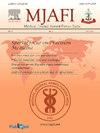2型糖尿病患者阻塞性睡眠呼吸暂停的患病率和影响:一项描述性横断面研究
Q2 Medicine
引用次数: 0
摘要
背景:据报道,阻塞性睡眠呼吸暂停(OSA)在2型糖尿病患者中发病率很高。关于印度人群中阻塞性睡眠呼吸暂停与糖尿病关系的文献很少。方法于2014年9月1日至2016年8月31日,在一家三级医院进行了一项横断面观察性研究,纳入80例连续且同意的糖尿病患者,为期24个月。在详细的病史和临床检查后,所有患者接受I级多导睡眠描记仪(PSG)检查,并抽血评估糖尿病控制、胰岛素抵抗和微血管并发症。结果80例糖尿病患者中,30例(37.5%)患者在柏林问卷中有高危评分,59例(73.8%)患者在PSG中有OSA的证据。体重指数、腰围和颈围正常的糖尿病患者的OSA患病率分别为65.5%、64.2%和67.2%。OSA患者的平均糖化血红蛋白显著增高(相关系数0.53),胰岛素抵抗显著增高(相关系数0.78)。有微血管并发症的患者的OSA患病率高于无微血管并发症的患者。这包括神经病变(100%对62.5%)、视网膜病变(100%对69.6%)和糖尿病肾病(DKD)(90.9%对52.8%)。有微血管并发症的患者发生OSA的可能性显著增加(优势比13.66,95%可信区间3.94-47.37,p <;0.001)。结论与肥胖无关,印度糖尿病患者OSA患病率较高。糖尿病和OSA患者糖尿病控制较差,胰岛素抵抗较多,肾病、神经病变、视网膜病变等微血管并发症发生率较高。本文章由计算机程序翻译,如有差异,请以英文原文为准。
Prevalence and impact of obstructive sleep apnea in type 2 diabetes mellitus: A descriptive cross-sectional study
Background
Obstructive sleep apnea (OSA) has been reported to have a high prevalence in patients with type 2 diabetes mellitus. There is scarcity of literature on relationship between OSA and diabetes in Indian population.
Methods
A cross-sectional observational study was conducted at a tertiary care hospital and 80 consecutive and consenting patients with diabetes were enrolled over 24 months from 01 Sep 2014 to 31 Aug 2016. After a detailed history and clinical examination, all patients were subjected to a level I polysomnography (PSG), and their blood sample was drawn for the assessment of diabetes control, insulin resistance, and microvascular complications.
Results
Out of 80 patients with diabetes, 30 (37.5%) patients had a high-risk score on Berlin questionnaire and 59 (73.8%) patients had evidence of OSA by PSG. The prevalence of OSA in diabetics with normal body mass index, waist circumference, and neck circumference was 65.5%, 64.2%, and 67.2%, respectively. Patients with OSA had a significantly higher mean glycosylated hemoglobin (correlation coefficient 0.53) and higher insulin resistance (correlation coefficient 0.78). Patients with microvascular complications had a higher prevalence of OSA than those without. This included neuropathy (100% versus 62.5%), retinopathy (100% versus 69.6%) and diabetic kidney disease (DKD) (90.9% versus 52.8%). Patients with any microvascular complication were significantly more likely to have OSA (odds ratio 13.66, 95% confidence interval 3.94–47.37, p < 0.001).
Conclusion
Indian patients with diabetes have a high prevalence of OSA, regardless of obesity. Patients with diabetes and OSA have poorer diabetes control, more insulin resistance, and higher prevalence of microvascular complications like nephropathy, neuropathy, and retinopathy.
求助全文
通过发布文献求助,成功后即可免费获取论文全文。
去求助
来源期刊

Medical Journal Armed Forces India
Medicine-Medicine (all)
CiteScore
3.40
自引率
0.00%
发文量
206
期刊介绍:
This journal was conceived in 1945 as the Journal of Indian Army Medical Corps. Col DR Thapar was the first Editor who published it on behalf of Lt. Gen Gordon Wilson, the then Director of Medical Services in India. Over the years the journal has achieved various milestones. Presently it is published in Vancouver style, printed on offset, and has a distribution exceeding 5000 per issue. It is published in January, April, July and October each year.
 求助内容:
求助内容: 应助结果提醒方式:
应助结果提醒方式:


